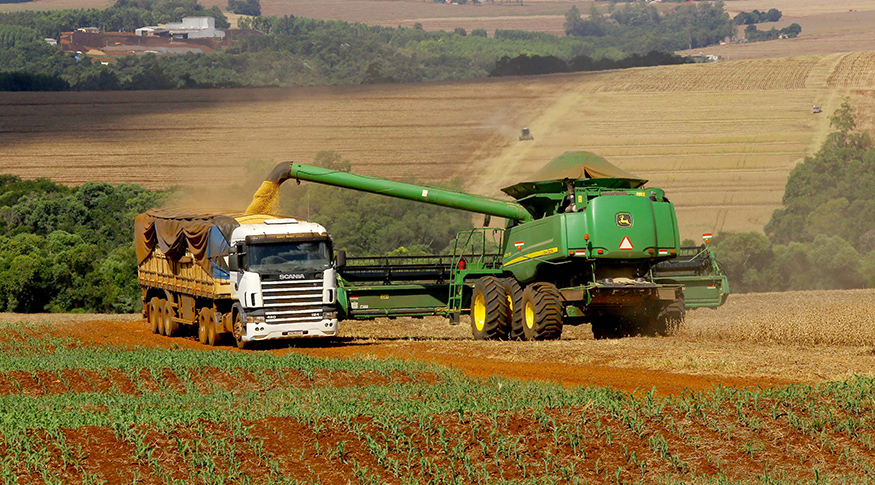Agricutural production
March estimate is 0.5% above February figure and points to record results in 2023 harvest
April 13, 2023 09h00 AM | Last Updated: April 13, 2023 10h53 PM

The Brazilian harvest of cereals, legumes and oilseeds is expected to reach a record 299.7 million tonnes in 2023, according to the March estimate of the Systematic Survey of Agricultural Production (LSPA), released today (13) by the IBGE. The figure is 13.9% above that in 2022 (263.2 million tonnes), an increase of 36.5 million tonnes.
From February, the harvest estimate increased by 0.5%, that is, by 1.6 million tonnes. A record is expected in the output of soybean and corn.
JáThe area to be harvested must reach 76.1 million hectares, a rise of 3.9% from 2022, with an increase by 2.9 million hectares. Against the previous month, the area to be harvested increased by 266,716 hectares (0.4%).
“The weather has been good in most producing Federation Units, as well as prices, which caused the producer to increase planted area. In the first crop, there was increase of soybean production; in the second one, of milk. That is the second highest estimate and record in the time series. Corn and soybean also reached record figures. There was a drop of 1.8% in output estimate regarding rice production, due to climate products in Rio Grande do Sul. Drops were also observed in terms of soybean and corn production in the state, but that was counterbalanced by the increased production in Mato Grosso and Paraná,” says Carlos Barradas, manager of LSPA.
Another highlight is the increase of 13% in output estimate of wheat due to the increase in output estimate of Paraná, a major producer of wheat, together with Rio Grande do Sul.
“Because of the war between Russia and Ukraine, two major producers, there have been opportunities for the increaseof production and exports of Brazilian wheat. The output estimate of wheat in Paraná increased by 33.2%, a result of a 14.1% increase in area and of 16.8% in productivity”, Mr. Barrada explains.
From February, the main increases in output estimates were those of wheat (13.0%), barley (11.7%), coffea canephora (2.9%), tomato (2.4%), soybean (1.5%), upland cottonseed (1.4%), beans - 1st crop (0.3%) and oat (0.1%).
On the other hand, there were drops in estimate for production of corn - 1st crop (-2.8%), tobacco (-1.8%), paddy rice (-1.8%), beans - 2nd crop (-1.3%), corn - 2nd crop (-0.9%), grape (-0.7%), coffea arabica (-0.3%) and beans = 3rd crop (-0.1%).
Agricultural production in Rio Grande do Sul has faced the effects of La Niña, characteried by severe drought, which resulted in drops in production in March.
“Last year the drought in Rio Grande do Sul was even more serious. Receovery has taken place this year, despite the climate. The state is our third main producer of grain,” Mr. Barradas says.
With a share of 30.9%, Mato Grosso leads national output of grain
Mato Grosso leads the national grain production with a share of 30.9%, followed by Paraná (15.7%), Rio Grande do Sul (10.2%), Goiás (9.3%), Mato Grosso do Sul (8.2%) and Minas Gerais (5.9%). This group of states accounted for 80.2% of the overall amount. As for participation of the Brazilian Major Regions, the distribution was as follows: Central-West (48.7%), South (28.1%), Southeast (9.4%), Northeast (8.7%) and North (5.1%).
In relation to the previous month, the main positive changes in production estimates occurred in Mato Grosso (4,118,190 t), Paraná (1,834,444 t), Rondônia (237,510 t), Maranhão (34,501 t), Ceará (9,953 t), Espírito Santo (3,566 t) and Amapá (1,180 t). The main negative change took place in Rio Grande do Sul (-4,616,815 t).
The estimated production of cereals, legumes and oilseeds registered a positive annual change in five Major Regions: South (28.4%), Central-West (11.6%), Southeast (1.0%), North (12.9%) and Northeast (2.5%). As for the monthly change, the Northeast Region (0.2%), the North (1.6%) and the Central-West (2.9%) recorded increases. The Southeast remained stable and the South recorded a decline (-3.2%).
About the LSPA
Launched in November 1972 aiming at addressing the demand of users for monthly short-term statistical information, the LSPA provides estimates of planted area, harvested area, amount produced and average yield of products selected based on criteria of economic and social importance for Brazil. It not only follows up each crop investigated in the calendar year of reference, from the intention to plant up to the end of the harvest, yet also the forecast of the harvest in the coming year, for which the months of October, November and December are surveyed. Please access the data at the Sidra database.


















